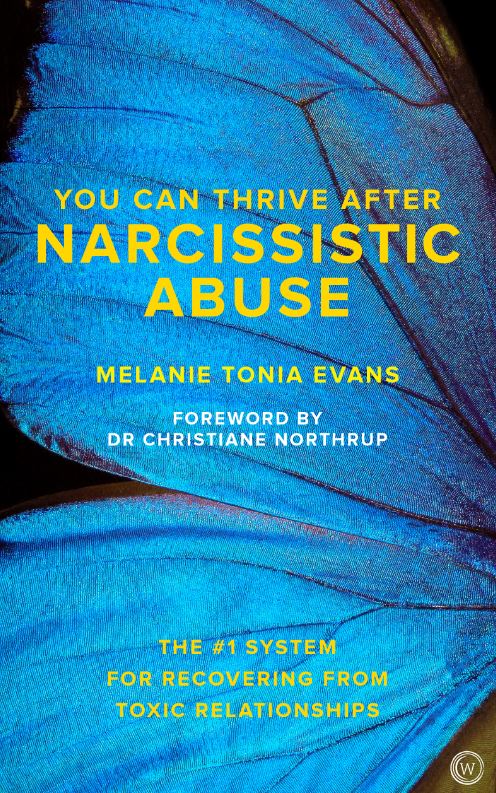The world’s foremost expert on narcissistic abuse, Melanie Tonia Evans, reveals the steps to recovery
Most of us think that we would never come into contact with someone with narcissistic tendencies let alone develop a relationship with one.
Sadly, our perceptions of what a narcissist is could not be further from the truth. In my new book You Can Thrive After Narcissistic Abuse: The 1 System for Recovering from Toxic Relationships, I take you through detailed, valuable steps on how to recognise and liberate yourself from a narcissist.
I have lived through narcissistic abuse as I was physically, psychologically and financially abused by my former husband for over five years – he even lied about his cancer condition to glean sympathy and attention.
However through my experience, I had an epiphany, which signalled the birth of my online recovery programmes the Quanta Freedom Healing Technique and the Narcissistic Abuse Recovery Program, which is the cornerstone of my book.
Narcissists can be difficult to identify, because their behaviour can be insidious and difficult to detect.
If you have any doubts about whether or not you are involved with someone with Narcissistic Personality Disorder (NPD) here are some of the key signs to look out for.
5 signs of Narcissistic Personality Disorder
- Narcissists are easily triggered into responses that normal well-adjusted adults just don’t make. It doesn’t matter what type of relationship you have with a narcissist, you will experience their insecurities in the form of defences, retaliations and immaturity.
- Narcissists make it ‘all about them’, once the initial love-bombing stage is over – where they shower you in interest – you will notice their high levels of entitlement and how all conversations circle back to them.
- Narcissists are likely to lie very early on in relationships, along with bragging about accomplishments from their past, which bare little resemblance to the actual facts.
- When you confront them, narcissists create circular arguments full of defences, allies and off topic accusations that can make you feel like you are losing your mind.
- Speaking about you unfavourably and spreading malicious lies is just one example of how a narcissist behaves. They might label you as the ‘abuser’ and smear you to the key people in your life.
Narcissists behave like drug addicts, frenetically hunting out the vulnerable, sucking them dry to relieve their inner void. What follows are the many consequences of narcissistic abuse.
4 signs your are being narcissistically abused
- Victims of narcissistic abuse are traumatised, terrorised and confused. Their ability to think and function is seriously impaired. Commonly they will suffer Post Traumatic Stress Disorder, anxiety, depression and a host of other mental, emotional and physical disorders.
- Due to the narcissist gaslighting and turning all the blame back on them, a person being narcissistically abused may feel defective and an intense shame.
- One encounters great difficulty getting others close to the victim to believe they are being abused. The victim often appears as the crazy one, and unless someone has gone through narcissistic abuse themselves others will think ‘If it’s that bad why don’t you just leave?’
- Extreme trauma-bonding occurs when there are a host of mental and physiological reasons why someone feels addicted to a narcissist, no matter how bad the abuse is. Withdrawal can feel like a death, hence why its commonplace to struggle to leave and stay away from the narcissist.
Narcissists behave like drug addicts, frenetically hunting out the vulnerable
What characterises narcissistic relationships is that the cycles of violence – emotional, psychological, financial, physical or all of the above – never end and actually intensify over time. Issues don’t heal but dissolve and worsen.
6 steps to healing after narcissistic abuse
Below are the vital steps to healing from a narcissistic relationship.
Step #1 No Contact
Ceasing all contact and blocking all forms of communication is the first step in your healing journey. In certain scenarios, such as joint parenting, you cannot simply wipe this person from your life, in such cases it is highly advisable to create strict ‘Modified Contact’ which means having communication regarding your children through third-party channels only, and setting up court orders for all agreements.
Every time you accept or initiate contact, you are handing the narcissist the ammunition to hurt you
Because of the extreme trauma bonding at play, inevitable repeat abuse and addiction to the narcissist, you have to accept that the only way to heal yourself is to pull away and cut your losses. Refraining from contact means you no longer keep hurting yourself. Every time you accept or initiate contact, you are handing the narcissist the ammunition to hurt you – they know your weak spots and how to wound you deeply.
Until we heal the parts of ourselves that hang on and try to force the narcissist to love us, we are going to keep craving that person, justifying to ourselves to give them one more chance.
By initiating No Contact and turning inwards to heal, the real work begins.
Step #2 Release the immediate trauma so that you can start to function again
To reclaim our power, we need to do the very opposite of what we once believed would work, that is, ‘If I can fix the narcissist, I’ll feel better on the inside”. Using my ‘Thriver Technique’ we turn this co-dependent thinking around and bring the power back to where it really lives – inside us. We take our focus away from the narcissist and give ourselves the full love and attention to heal ourselves back to wholeness.
Understanding who a narcissist is and what they do is important initially, but it doesn’t heal our internal trauma. What we need to do is resolve and release our horrific traumas then we can liberate ourselves.
We find, very quickly, that when we stop handing the narcissist our power and instead look to heal inside, relief and balance start to rise up in us again.
Step #3 Forgive yourself for what you have been through
When the insecure and wounded parts of ourselves remain unhealed, we behave like damaged children looking for approval from an abusive parent. We give our power away to toxic people.
We throw away robust resources such as our health, money and time on people who are like black holes and never really loved us. Sadly in the process we may have also hurt and disappointed the people in our life that we really love, like our children.
Understandably, it can be hard to forgive ourselves for this. We may also believe that we won’t be able to rebuild our life from everything we’ve lost in the process which tends to happen more when we experience narcissistic abuse in middle age.
It is only by working through our healing that we can find resolution and acceptance. We can move away from old patterns of not respecting and loving ourselves to living our truth being responsible for our well-being.
When we forgive ourselves knowing that this was all a part of our learning, we can accept our experiences and reclaim our lives.
When we release the regret and self-judgment of past mistakes, we start to set ourselves free to manifest greatness in our life, no matter what stage we’re at. Then we can ‘break through’ to feeling hope again.
Step #4 Release and heal the fear of the narcissist – and whatever they may do next
Remaining in fear, pain and distress is like bait to a narcissist and can perpetuate the cycle of abuse, even if we’re separated from them.
It’s very true that narcissists can be relentless. They don’t like losing or won’t want you to move forward to a happy healthy life, however, they’re nowhere near as powerful and impactful as you may think.
Narcissists need your fear and distress to operate. When you heal your inner trauma hook – the narcissist’s ploys fall apart. If you become grounded, unflappable and stoic and don’t feed into their drama – the narcissist loses their power and credibility.
This is one of the most important steps of the Thriver technique, and is totally achievable if you follow it.
Step #5 Release the connection to the narcissist
Many people have likened the process of freeing themselves from a narcissist to that of an exorcism.
I believe that in liberating ourselves from the darkness that has infiltrated our being, we detox and fill ourselves with light and life-force. We need to release all the previous trapped parts trying to survive into a pure creative force.
Ridding yourself of the narcissist means not just cutting the cords, but also releasing all the associated belief systems that unconsciously hooked you in in the first place. It’s only then that we can break free to a New Self, no longer an energetic target for a narcissist, move on, start again and create a new beginning.
Although it may be tempting to seek revenge on the narcissist, this is something to avoid completely as it will only immerse you back into darkness and drag you into a game, which the narcissist is an expert at.
The best revenge is a life where you take hold of your freedom and make the narcissist completely irrelevant. Nothing hurts their ego more, and they become powerless to affect you. They give up, because you become a constant reminder of how non-existent they really are.
It’s then that it ends because your soul contract to go within and love and heal yourself back to wholeness has been completed. Like a cancer that delivers its wake-up call, the disease then disappears – so does the narcissist when you evolve to your truest and most Thriving self.
Step #6 Realise your liberation, freedom and truth
Loving ourselves can be incredibly difficult due to human conditioning where we’re taught that self-love is selfish, when in reality it’s a crucial step for not just releasing narcissistic abuse but real liberation.
Society has taught us that other people treat us how we treat them. This is a false premise, people treat us how we treat ourselves and we only ever receive love that matches how we truly feel about ourselves.
people treat us how we treat ourselves
It is only by healing and becoming whole that we can love others in real and healthy ways. This is a template that is vital to teach our children so that they don’t carry the unconscious abuse patterns of our forefathers.
It all starts by taking personal responsibility to heal the only person we can ever truly have power over – ourselves so that, one person at a time, we become the change we wish to see. It’s then that we can let go of playing a victim and stop handing over our lives to the narcissist.
We take back our life by doing the necessary internal healing work regardless of what the narcissist does or doesn’t do which is irrelevant anyway. We can then go onto Thrive not ‘despite’ what happened to us but ‘in spite’ of what happened to us.
Melanie Tonia Evans is the author of You Can Thrive After Narcissistic Abuse: The 1 System for Recovering from Toxic Relationships and in all good book stores. She is considered to be the world’s leading online authority on narcissistic abuse recovery. As a survivor of Narcissistic Abuse herself, she is the founder of Quanta Freedom Healing (QFH) and the Narcissistic Abuse Recovery Program (NARP). Through her programmes, Mel has helped thousands of people worldwide – there are now over 20,000 graduates of the Narcissistic Abuse Recovery Program who are presently Thriving in abuse-free lives. To find out more visit: melanietoniaevans.com
More Healthista Content:
‘I was addicted to my alcoholic partner’
9 ways to lose weight for shift workers
Rheumatoid arthritis almost paralysed this woman – here’s how she beat it
I asked my exes for dating advice and this is what happened
Like this article? Sign up to our newsletter to get more articles like this delivered straight to your inbox.


























































